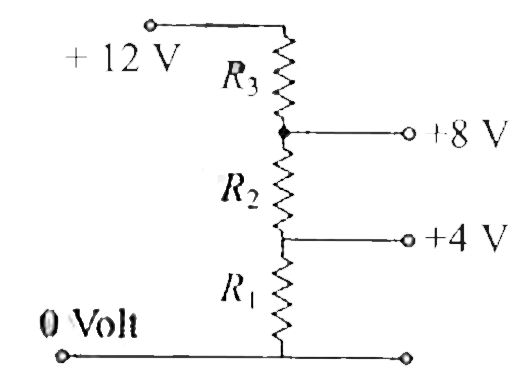Three resistances R1,R2andR3 are coonected in parallel . This combination is then connected to a celll of negligble internal resistance .Applying Kirchhoff's law prove that the equivalent resistance of the whole combination is give by ,
R=R1R2R3R1R2+R2R3+R1R3Solution in Bengali
Applying Kirchhoff's second law in the closed loop AR1BEA ,
i1R1−E=0
[ where emf of the cell is E and internal resistance is zero ]
∴i1=ER1 ....(1)

Again applying Kirchhoff's second law in AR2BEA ,
i2R2−E=0
∴i2=ER2 ....(2)
and similarly , i3=ER3 ...(3) ltbr gt From equatios (1) ,(2) and (3) we get ,
i1+i2+i3=E[1R1+1R2+1R3]=i[i=total current]
If R be the equivalent reistance then
R=Ei=11R1+1R2+1R3=R1R2R3R1R2+R2R3+R1R3
Topper's Solved these Questions
- KIRCHHOFF'S LAWS AND ELECTRICAL MEASUREMENT Book:CHHAYA PUBLICATIONChapter:KIRCHHOFF'S LAWS AND ELECTRICAL MEASUREMENT Exercise:NCERT TEXTBOOK QUESTIONS WITH ANSWER HINT
Explore 10 Videos
- KIRCHHOFF'S LAWS AND ELECTRICAL MEASUREMENT Book:CHHAYA PUBLICATIONChapter:KIRCHHOFF'S LAWS AND ELECTRICAL MEASUREMENT Exercise:NCERT EXEMPLAR QUESTIONS WITH ANSWER HINT (MCQ -1)
Explore 2 Videos
- KIRCHHOFF'S LAWS AND ELECTRICAL MEASUREMENT Book:CHHAYA PUBLICATIONChapter:KIRCHHOFF'S LAWS AND ELECTRICAL MEASUREMENT Exercise:Section Related Questions
Explore 14 Videos
- ELEMENTARY PHENOMENA OF ELECTROSTATICS Book:CHHAYA PUBLICATIONChapter:ELEMENTARY PHENOMENA OF ELECTROSTATICS Exercise:EXAMINATION ARCHIVE
Explore 2 Videos
- LIGHT WAVE AND INTERFERENCE OF LIGHT Book:CHHAYA PUBLICATIONChapter:LIGHT WAVE AND INTERFERENCE OF LIGHT Exercise:CBSE SCANNER
Explore 15 Videos
Similar Questions
Determine the current in each branch of the network shown in Fig

View SolutionA student chooses the stancdard resistance S to be 100Ω while measuring a resistance R by using a metre bridge He finds the null point at l1=2.9 cm . He is told to attempt to improve accuracy . Which of the following is a useful way ?
View SolutionWhat do you mean by node analysis and mesh analysis?
View SolutionDefine surface density of electric charge
View SolutionIn Young's double slit experiment derive the condition for (i) constructive interference and (ii) destructive interference at a point on the screen.
View Solution(r_(3)+r_(1))(r_(3)+r_(2))sin C=2r_(3)sqrt(r_(2)r_(3)+r_(3)r_(1)+r_(1)r_(2))
View SolutionA potential divider is used to give outpurs of 4V and 8V from a 12V source. Which combination of resistance, (R1,R2,R3 gives the correct voltages? (R_(1) : R_(2) : R_(3)

View SolutionShow that if three slabs of thermal resistance R1,R2 and R3 are placed in contact, the thermal resistance of the compound slab is given by R=R1+R2+R3.
View SolutionTwo resistors of resistances R_(1)=100 pm 3 ohm and R_(2)=200 pm 4 ohm are connected (a) in series, (b) in parallel. Find the equivalent resistance of the (a) series combination, (b) parallel combination. Use for (a) the relation R=R_(1)+R_(2) and for (b) 1/(R')=1/R_(1)+1/R_(2) and (Delta R')/R'^(2)=(Delta R_(1))/R_(1)^(2)+(Delta R_(2))/R_(2)^(2)
View Solutionतीन प्रतिरोध R1,R2 और R3 समांतर क्रम में जोड़े गए है ।तुल्य प्रतिरोध की गणना कीजिए ।
View SolutionProve that r1(r2+r3)√r1r2+r2r3+r3r1=a
View SolutionStatement-1: ln !ABC,r1+r2+r3−r=4R
Statement-2: In !ABC,r1r2+r2r3+r3r1=!2
View SolutionA resistance R_(2) is connected in parallel with a resistance R_(1) what resistance R_(3) must be connected in series with the combination of R_(1) and R_(2) so that the equivalent resistance is equal to the resistance R_(1) -
View SolutionProve the questions
a(rr1+r2r3)=b(rr2+r3r1)=c(rr3+r1r2)
View SolutionTwo resistors of resistance R1 and R2 having R1>R2 are connected in parallel. For equivalent resistance R, the correct statement is
View Solution

